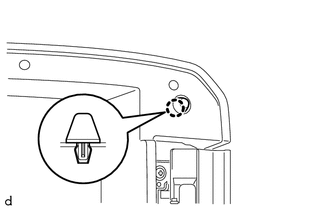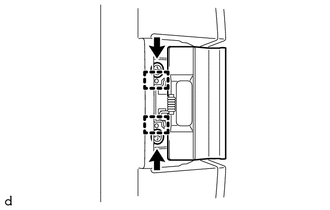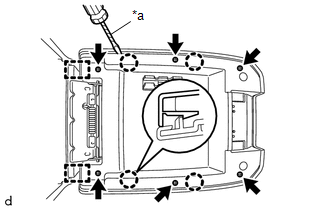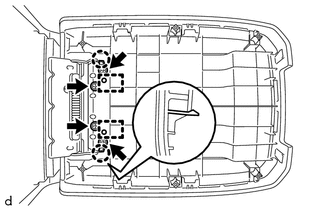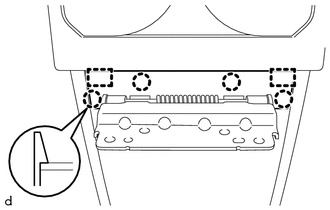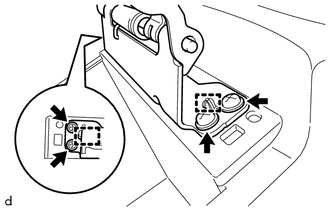Toyota Tacoma (2015-2018) Service Manual: Disassembly
DISASSEMBLY
PROCEDURE
1. REMOVE CONSOLE COMPARTMENT DOOR CUSHION
HINT:
Use the same procedure as for the opposite side.
|
(a) Disengage the claw to remove the console compartment door cushion. |
|
2. REMOVE CONSOLE COMPARTMENT DOOR SUB-ASSEMBLY
|
(a) Remove the 2 screws. |
|
(b) Disengage the 2 guides to remove the console compartment door lock lever.
|
(c) Remove the 6 screws. Text in Illustration
|
|
(d) Using a screwdriver with its tip wrapped in protective tape, disengage the 4 claws and 2 guides to remove the console compartment door sub-assembly.
3. REMOVE CONSOLE COMPARTMENT OUTER DOOR
|
(a) Remove the 4 screws. |
|
(b) Disengage the 2 claws and 2 guides to remove the console compartment outer door.
4. REMOVE CONSOLE COMPARTMENT DOOR HINGE SUB-ASSEMBLY
|
(a) Disengage the 4 claws and 2 guides to remove the console compartment door moulding cover. |
|
|
(b) Remove the 4 screws. |
|
(c) Disengage the 2 guides to remove the console compartment door hinge sub-assembly.
 Components
Components
COMPONENTS
ILLUSTRATION
ILLUSTRATION
...
 Removal
Removal
REMOVAL
PROCEDURE
1. REMOVE SHIFT LEVER KNOB SUB-ASSEMBLY (for Automatic Transmission)
(a) Using a molding remover A, disengage the 2 claws to separate the
shifting hole cover sub-as ...
Other materials:
Transfer Case Rear Oil Seal
Components
COMPONENTS
ILLUSTRATION
Replacement
REPLACEMENT
PROCEDURE
1. DRAIN TRANSFER OIL
2. REMOVE PROPELLER WITH CENTER BEARING SHAFT ASSEMBLY
(See page )
3. REMOVE OUTPUT SHAFT COMPANION FLANGE SUB-ASSEMBLY
4. REMOVE TRANSFER EXTENSION HOUSING TYPE T OIL SEAL
( ...
System Description
SYSTEM DESCRIPTION
1. WIRELESS DOOR LOCK CONTROL SYSTEM
The wireless door lock control system functions to lock and unlock all the doors
from a distance. The system is controlled by a door control transmitter module set
sub-assembly which sends radio waves to the door control receiver. The mai ...
ACC Signal Circuit
DESCRIPTION
This circuit detects whether the ignition switch is ACC or off, and sends this
information to the main body ECU (multiplex network body ECU).
WIRING DIAGRAM
CAUTION / NOTICE / HINT
NOTICE:
Inspect the fuses for circuits related to this system before performing
the fo ...

